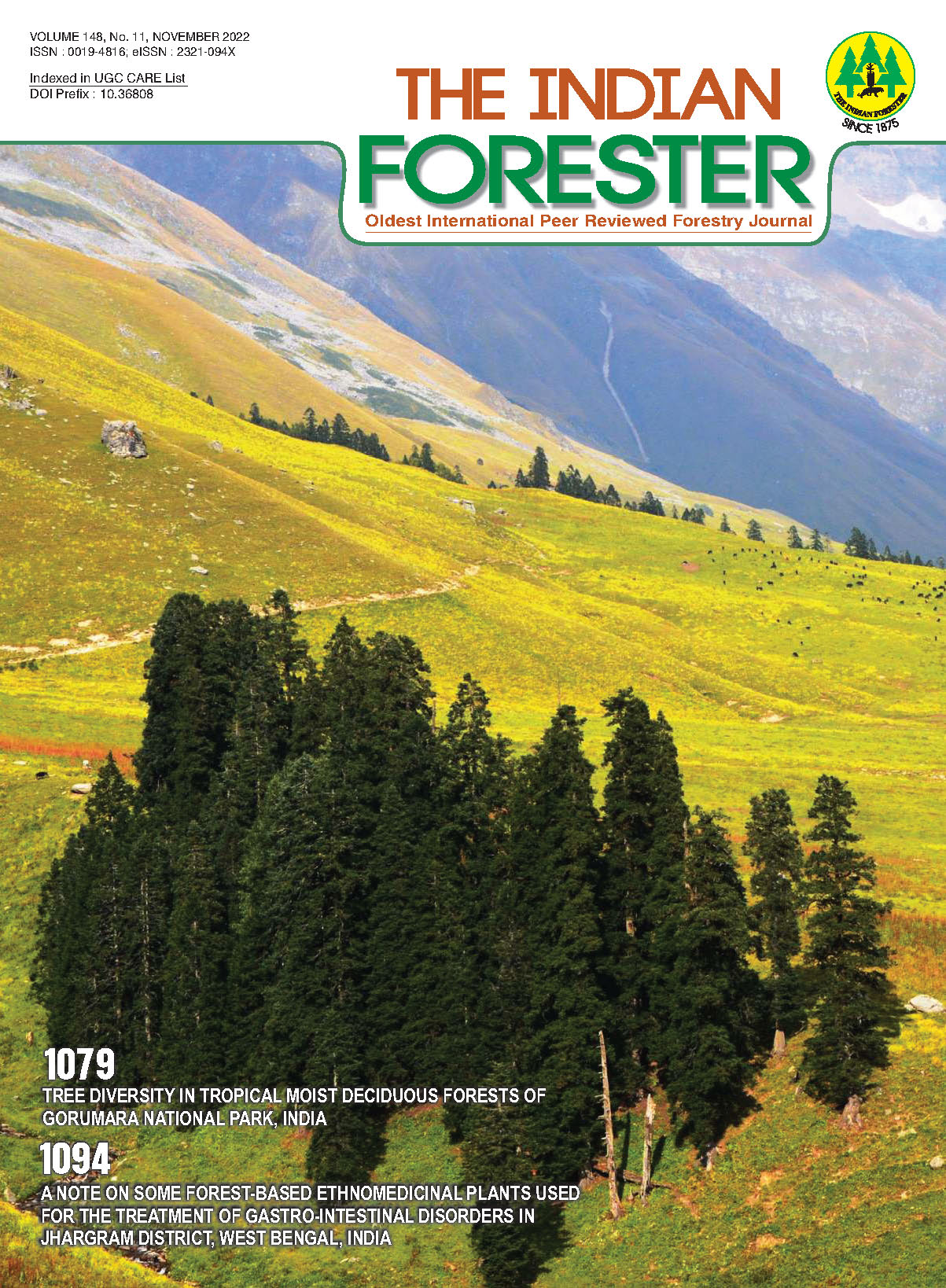Ethnobotanical Diversity of some Wetland Plants of North-East India: Implications for Conservation
DOI:
https://doi.org/10.36808/if/2022/v148i11/158704Keywords:
Hydrophytes, Traditional Knowledge, Secondary metabolites, Tripura.Abstract
The present paper mainly focuses on ethnobotanical diversity of wetland plants of Khowai River System of Tripura, North-East India, a trans-boundary river that originates in the eastern part of the Atharamura Hills of Tripura. Field survey was conducted in and around the river system to collect information about the wetland flora. Data on the use of plants was collected with a semi structured questionnaire and from the peer-reviewed literature. A total of 43 angiosperm species belonging to 36 genera under 24 families were identified along with their family, botanical name, vernacular name. In the biological spectrum, the dicotyledons are the most divergent because of number of species and genera. The depth of the river is gradually shrinking due to severe anthropogenic factors, therefore, there is an urgent need to conserve the biodiversity as well as quality of drinking water.References
Allen, S.D., Golet, F.C., Davis, A.F. and Sokoloski, T.E. (1989). Soil-vegetation Correlations in Transition Zones of Rhode Island Red Maple Swamps, Biology Reports, 89(8). Washington, DC: U.S. Fish and Wildlife Service.
Chaudhary, S. and Kumar, R. (2011). Some important medicinal trees of district Bijnor, Recent Research in Science and Technology, 3: 96-100.
Cunningham, AB. (2001). Applied ethnobotany, people wild plant use and conservation. Earthsean Publishing Ltd, London.
Deb, D., Darlong, L., Sarkar, A., Roy, M. and Datta, B.K. (2012). Traditional ethno- medicinal plants use by the Darlong tribes in Tripura, Northeast India, International Journal of Ayurvedic and Herbal Medicine, 2 (6):954-966.
Deb, D.B. (1981, 1983). The Flora of Tripura State, Vols.I and II. Today and Tomorrow’s Printers and Publishers, New Delhi.
Fassett, N.C. (2000). A Manual of Aquatic Plants. Agrobiosis (India), Jodhpur.
Huntington, H.P. (2000). Using Traditional ecological knowledge in science: Methods and applications, Ecological Applications, 10 (5):1270-1274.
Jain, S.K. and Rao, R.R. (1977). A Handbook of Field and Herbarium Methods. Today and Tomorrow’s printers and Publishers, New Delhi.
Jain, S.K. (1987). Glimpses of Indian ethnobotany, Oxford and IBH publishing Co, New Delhi, pp 231-241.
Karim, R., Ferdous, N., Roy, N., Jahan, M.G.S., Sarkar, A.K. and Shovon, M.S. (2015). A Study on Nutritional Components of the leaf and stem of Alocasia indica L., Journal of Advances in Applied Sciences and Technology, 2(1): 46-54.
Kumar, S., Das, G., Shin, H.S., Kumar, P. and Patra, J.K. (2018). Diversity of plant species in the steel city of Odisha, India:Ethnobotany and implications for conservation of urban bioresources, Brazilian archives of Biology and Technology, 61:1-19.
Lacoul, P. and Freedman, B. (2006). Environmental influences on aquatic plants in freshwater ecosystems, Environmental Reviews, 14:89-136.
Mahadkar, S., Valvi, S. and Varsha, R. (2012). Nutritional assessment of some selected wild edible plants as a good source of mineral, Asian Journal of Plant Science and Research, 2(4): 468-472.
Maltby, E. and Turner, R.E. (1983). Wetlands are not wastelands, Geogra manage LV. pp.92-97.
Maltby and Acreman (2011). Ecosystem services of wetlands: pathfinder for a new paradigm, Hydrological Sciences Journal-Journal des Sciences Hydrologiques, 56 (8): 1341-1359.
Marndi, S., Mishra, S. and Mishra, A.K. (2020). Wetland flora of Odisha against skin infections, Journal of Biodiversity and Conservation, 4 (2): 328-340.
Misra, D., Mandal, M., Ghosh, N.N. and Mandal, V. (2020). Extraction and volatile compounds profiling of the bioactive fraction of Monochoria hastata (L.) solms., Pharmacognosy Magazine, 16 (5): 517-523.
Mohmood, A., Qureshi, R.A., Mahmood, A., Sangi, Y., Shaheen, H., Ahmad, I. and Nawaz, Z. (2011). Ethnobotanical survey of common medicinal plants used by people of district Mirpur, AJK, Pakistan, Journal of Medicinal Plant Research , 5 (18):4493-4498.
Ong, G.H., Yap, C.K., Maziah, M. and Tan, S.G. (2011). Heavy Metal Accumulation in a Medicinal Plant Centella asiatica from Peninsular Malaysia, Journal of Biological Sciences 11 (2): 146-155.
Rashid, A. (2013). Dye yielding plant diversity of district Rajouri Jammu and Kashmir state-India, International Journal of Pharma and Bio Sciences, 4 (1):263-266.
Reid, G.K. (1961). Ecology of Inland Waters and Estuaries. Reinfold Publication Corporation, New York.
Rishikesh, Ghosh, D.R., Miah, S.H., Haque, A. and Islam, A. (2013). Phytochemical and antimicrobial investigation of Nymphaea leaf national flower of Bangladesh, Journal of Drug Discovery and Therapeutics, 1 (8):64-69.
Saxena, N., Yadav, V.K. and Verma, R.K. (2014). Traditional knowledge of medicinal plants used to cure gastrointestinal problems in Jalan district of Uttar Pradesh, India. Journal of Medicinal Plant Studies, 2: 24-28.
Sen, S., Chakraborty, R., De, B. and Devanna, N. (2011). An ethnobotanical survey of medicinal plants used by ethnic people in West and South district of Tripura, India. Journal of Forestry Research, 22:417-426.
Strayer, D. and Dudgeon, D. (2010). Freshwater biodiversity conservation: recent progress and future challenges. Journal of the North American Benthological Society, 29 (1): 344-358.
Temesgen, M. and Ratta, N. (2015). Nutritional potential, health and food security benefit of Taro Colocasia esculenta (L.): A Review, The open food science Journal.
Umar, K.J, Hassan, L.G., Dangoggo, S.M. and Ladan, M.J. (2007). Nutritional Composition of Water Spinach (Ipomoea aquatica Forsk.) Leaves, Journal of Applied Sciences, 7 (6):803-809.
Vasu, K., Jakku, V.G., Suryam, A. and Charya, S.M. (2009). Bimolecular and photochemical analysis of three aquatic angiosperms, African Journal of Microbiology Research, 3 (8):418-421.
Downloads
Downloads
Additional Files
Published
How to Cite
Issue
Section
License
Unless otherwise stated, copyright or similar rights in all materials presented on the site, including graphical images, are owned by Indian Forester.





